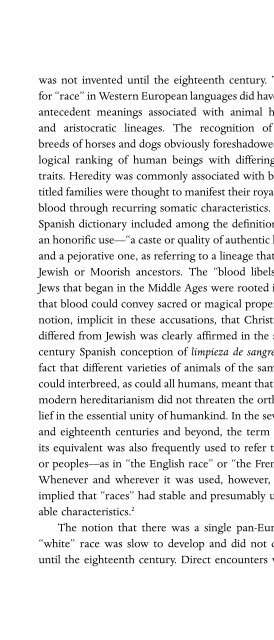Racism - A Short History - George M Fredrickson.pdf - WNLibrary
Racism - A Short History - George M Fredrickson.pdf - WNLibrary
Racism - A Short History - George M Fredrickson.pdf - WNLibrary
You also want an ePaper? Increase the reach of your titles
YUMPU automatically turns print PDFs into web optimized ePapers that Google loves.
THREE Climax and Retreat<br />
Prominent among the liberal interracialists of the interwar<br />
years were Jewish immigrants like Boas who could<br />
identify with the victims of racism because of their own<br />
experiences with European antisemitism. Changing white<br />
attitudes reflected to some extent a growth in black political<br />
power. The shift of African American population from the<br />
South to the North made blacks once again voters. By the<br />
1930s, they were numerous enough to decide close elections<br />
in some major cities and pivotal industrial states, and<br />
the Democrats welcomed them into their urban/ethnic coalitions.<br />
In the South, however, conditions remained virtually<br />
unchanged in the postwar years. The new political<br />
clout of northern blacks and the enhanced power of the<br />
federal government as a result of the New Deal had yet to<br />
be translated into an assault on the Jim Crow system, which<br />
was still sustained by the constitutional doctrine of states’<br />
rights and the southern Democratic Party’s wholehearted<br />
commitment to white supremacy.<br />
In South Africa a substantial migration of blacks from<br />
the countryside to the cities during and after the Great War<br />
was also accompanied by an increase in the extent and<br />
intensity of African protest politics. But rather than an<br />
enhancement of black power and a mellowing of white attitudes,<br />
something like the reverse occurred. “Influx controls”<br />
on migrants, along with confinement to segregated<br />
townships or compounds of those who received permission<br />
to remain in urban-industrial areas, set the basic pattern<br />
for the system of labor coercion that would be fully and<br />
ruthlessly implemented during the apartheid era. The interwar<br />
period was one of increasing repression and denial<br />
of rights, culminating in 1936 when all Africans were re-<br />
116
















